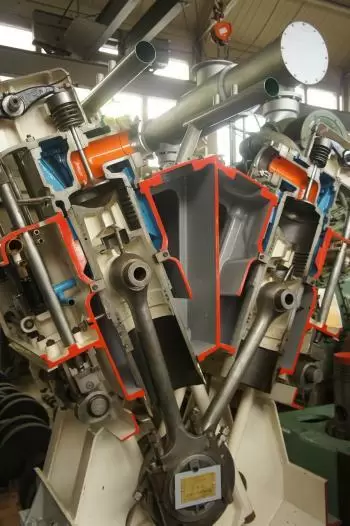
An endothermic engine, commonly known as an internal combustion engine (ICE), is a type of reciprocating heat engine that converts chemical energy from fuel into mechanical work using the principles of thermodynamics. It achieves this by burning fuel inside a combustion chamber, generating high-temperature gases that expand and create motion.
The most well-known types of endothermic engines include:
- The Otto engine (gasoline engine), which operates on the Otto cycle.
- The Diesel engine, which follows the Diesel cycle.
Why Is It Called an Endothermic Engine?
The term "endothermic", in a strict sense, refers to a process that absorbs heat, but in the context of engines, it is often used to describe internal combustion, where fuel and air are burned inside a closed chamber. The combustion process raises the pressure and temperature, producing mechanical energy that powers vehicles.
How Does an Endothermic Engine Work?
An endothermic engine consists of several interconnected components that work together to generate rotational energy, which ultimately moves a vehicle.
- Air and Fuel Intake – The engine draws in air and fuel (gasoline, diesel, LPG, or alternative fuels).
- Compression – The piston compresses the fuel-air mixture inside the cylinders, increasing pressure and temperature.
- Combustion – A spark plug (in gasoline engines) or high compression (in diesel engines) ignites the fuel, causing an explosion that pushes the pistons downward.
- Energy Conversion – The piston movement rotates the crankshaft, which transfers energy to the transmission system and ultimately to the vehicle's wheels.
- Exhaust Emission – Burned gases exit through the exhaust system, reducing pressure in the cylinders for the next cycle.
Types of Endothermic Engines
There are two main classifications based on how combustion occurs:
- Spontaneous Combustion Engines (Diesel Engines) – These engines use high compression to ignite diesel fuel without needing a spark plug.
- Induced Combustion Engines (Gasoline & LPG Engines) – These require an external ignition source, such as a spark plug, to start combustion.
The Evolution of Endothermic Engines
The first experimental internal combustion engines appeared in the late 1800s, paving the way for the development of the modern automobile. Over the decades, technological advancements have improved engine efficiency, fuel consumption, and emissions control.
However, the environmental impact of fossil-fuel-based endothermic engines has become a major concern. The exhaust gases they produce contain carbon dioxide (CO₂), nitrogen oxides (NOₓ), and particulate matter, which contribute to air pollution and climate change.
How Efficient Is an Endothermic Engine?
The efficiency of an endothermic engine depends on several factors:
- Displacement (Engine Size) – Larger engines generally produce more power but consume more fuel.
- Power Output (Horsepower or Kilowatts) – The energy an engine generates is proportional to fuel combustion efficiency.
- Forced Induction (Turbocharging & Supercharging) – These technologies improve power output but can increase fuel consumption.
- Fuel Type and Quality – Different fuels have varying energy densities and combustion properties.
In modern automotive engineering, hybrid and turbocharged engines are improving efficiency, balancing performance and fuel economy.
Are There Environmentally Friendly Endothermic Engines?
For over a century, fossil fuels were considered the best solution for transportation, but they have significant environmental drawbacks. The burning of petroleum-based fuels releases harmful pollutants and accelerates the greenhouse effect.
Sustainable Alternatives to Traditional Endothermic Engines
- Hybrid Engines – Combine internal combustion with electric motors to reduce fuel consumption in cities.
- Electric Motors – Fully electric vehicles (EVs) eliminate emissions, but their environmental impact depends on the source of electricity (renewable vs. fossil fuel).
- Hydrogen-Powered Engines – Hydrogen combustion produces only water vapor, making it a promising alternative, though its adoption is still limited.
- Compressed Air Engines – Experimental technologies are exploring the use of compressed air instead of fuel combustion.
Conclusion
Endothermic engines have powered modern transportation for over a century, but their future is being challenged by environmental concerns and regulatory restrictions. As alternative energy sources become more viable, electric and hydrogen-powered engines may gradually replace traditional internal combustion engines. In the meantime, hybrid technologies and fuel efficiency innovations continue to improve the sustainability of endothermic propulsion